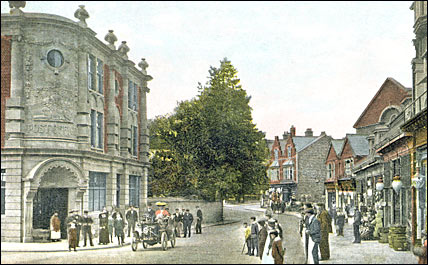|
|||
| Northamptonshire Life Magazine, September 1986, transcribed by Susan Manton | |||
|
Our First Motor-car at Rushden |
|||
|
By Frances Ida Clark |
|||
|
|||
|
It was autumn, the gas had been lit in the hall and three expectant children were waiting. Mother had told us that the car was due to arrive at any moment and we would be allowed to ride round in it to the garage. What preparations had been made for this vehicle in that year of 1907! A new place had to be found for it. The coach house where the trap and landau were housed could not be used, so the builders had gone to work and had erected a double garage close to the house, complete with inspection pit. Presently a crunching noise was heard on the gravel and I and my sister Catherine and brother Eric, knew it had arrived at the front door. Our father got out and escorted us to the brand new Belsize. It looked something like a In those times a chauffeur was an absolute necessity because as you can imagine these primitive vehicles were very temperamental. It would have been irksome for the owner, generally a very busy man, to have looked after the thousand and one things that went wrong, whereas the chauffeur was a dedicated man and, assisted by the mechanic, would put things right, at least temporarily. For this the inspection pit was in constant use and after a journey, whether the care went well or badly, it was always examined. In the open front seat sat the driver and passenger, and segregated from them was the main accommodation for another four people, two of whom sat on little seats. The windscreens were on hinges and fastened to the ceiling with a button if the weather was sultry, but more often the screens were used for protection against wind and rain. It could be cold in the front seat and my father had a coat lined with fur and with beaver lapels to keep him warm. We soon changed chauffeurs and Mr Joe Jeffries, who became our new driver, wore a green box coat with gilt buttons specially made for him. Joe was a tall fellow so the speaking tube which he was supposed to use to communicate with the inside only came up to the middle of his back. There was an oil sump of brass opposite the passenger seat. I used to sit with my father, my duty being to watch this and if it stopped bubbling I had to tell my father who meanwhile admired the scenery. The roads in those days had no tarmacadam so there was plenty of dust which flew about in whirlwinds as we went along. To keep the upholstery of the car in good condition a set of We created quite a sensation in the town as we swept past in this vehicle, children and adults ran out to watch us. We were of as much interest as the first aeroplanes about the same time. My mother used to wear a motor hat with a peak and much veiling and we wore what were called motor bonnets which fastened with strings under the chin so they did not blow off when we had the hood down, which we frequently did. We covered a lot of new territory in this vehicle. I remember going to We used to spend our August holidays at Wells, I remember going to We often had incidents such as wheels coming off and overheating of the engine and when we could not budge we had to leave the car behind and come back by train. My father did not like to see us in our motor bonnets on these occasions so we stopped wearing them.
We kept the Belsize until 1918 when Father bought a Schneider instead.
|
|||
|
|
|||
|
|
